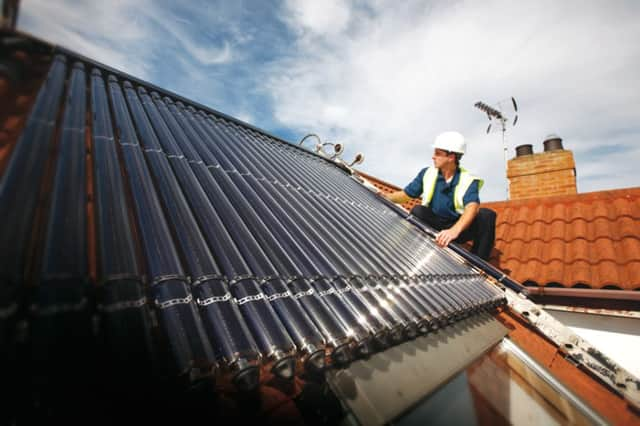Battle heating up to beat fuel poverty


While Scotland can genuinely be regarded as a world leader in its drive for a sustainable energy future, there is an elephant in the room.
For the 900,000 Scottish households in fuel poverty, the battle to keep warm is a day-to-day slog for which the price, sadly, is often literally too high.
Advertisement
Hide AdAdvertisement
Hide AdIn a country with an average annual mean temperature of just 7.5 Celsius, it’s hardly surprising that keeping the chill at bay is one of the greatest challenges we face.
Already, half of the energy we use is in the invisible but vital form of heat.
While hydro power, wind turbines, bioenergy and solar pv systems generate the equivalent of almost half of our electricity, Scotland’s heat sector is often forgotten.
A Scottish Government target that 11 per cent of our heat should be generated from renewable sources by 2020 is still achievable, but only just – the most up-to-date statistics show that figure currently at just 2.6 per cent.
The introduction last month of the domestic Renewable Heat Incentive (RHI), following on from the Scottish Government’s Heat Policy Statement in March, at last gives us an opportunity to begin to address that challenging target.
The legislation allows householders with renewable heat systems to claim money back from the Government for the heat they generate, much as those with solar pv panels already do for the electricity they produce.
Last year, Scottish Renewables led nine other concerned organisations in asking the Department of Energy & Climate Change to change its plans for the domestic RHI. We asked that the legislation was extended to cover social landlords, meaning thousands of the poorest people in our society would be able to reap the benefits of affordable, renewable heat – particularly important as a quarter of all homes in Scotland are classed as social housing.
Our request was successful, and those social landlords – many of whom have already installed biomass boilers, solar thermal systems and heat pumps – are now looking forward to an income from these technologies.
Advertisement
Hide AdAdvertisement
Hide AdIssues, though, persist. The Scottish Federation of Housing Associations, a partner in last year’s drive to shift the focus of the domestic RHI towards poorer households, quickly spotted one weakness in the legislation after its launch on 9 April.
Social landlords wishing to qualify under the RHI must first undergo a Green Deal assessment for each applicable household – a significant added cost.
Green Deal assessments are designed to discover whether there is the potential to install energy efficiency measures in a home. They form the basis for an application under the Green Deal – a different Government scheme which gives householders the opportunity to purchase energy efficiency upgrades for their homes, then pay off the balance through the savings made on their energy bills.
While paying for a Green Deal assessment may be reasonable for individual homeowners, it is often unnecessary for social landlords, who know their housing stock well and who have already invested in low-cost energy efficiency measures such as double glazing and loft and wall insulation.
We have to be cautious from a fuel poverty point of view, then, about trumpeting the potential of the domestic RHI.
Fuel poverty affects some of the most vulnerable members of our society – people who often struggle to make ends meet, let alone afford new heating systems for their homes. Questions have been asked about whether the scheme will disproportionately benefit the wealthy middle classes, given the money and time needed to undertake the improvements required, so the benefits to those most in need of help with their fuel bills remain to be seen.
The launch of the Scottish Government’s draft Heat Generation Policy Statement at the start of March this year acknowledged for the first time that we need district heating, biomass, geothermal energy, solar thermal systems and heat pumps to become commonplace in homes, businesses and on industrial sites across Scotland.
This process, which will play a key role in cutting carbon emissions from the fossil fuels currently used to generate much of our heat, will create hundreds of jobs and drive a step-change in the way Scotland thinks about keeping warm.
Advertisement
Hide AdAdvertisement
Hide AdWhile plans for large combined heat and power plants in Rosyth and Grangemouth face an uncertain future after the withdrawal of SSE support in March, it is vitally important that industry and government continue to work together to ensure that these schemes can flourish in Scotland.
The UK has ambitious aspirations for renewable heat, and the RHI, alongside the Scottish Government’s Heat Generation Policy Statement, give us a welcome boost towards achieving them. But there are still issues to be resolved, and it’s up to us all to work together to make that happen.
• Stephanie Clark is policy manager at Scottish Renewables, www.scottishrenewables.com
SEE ALSO